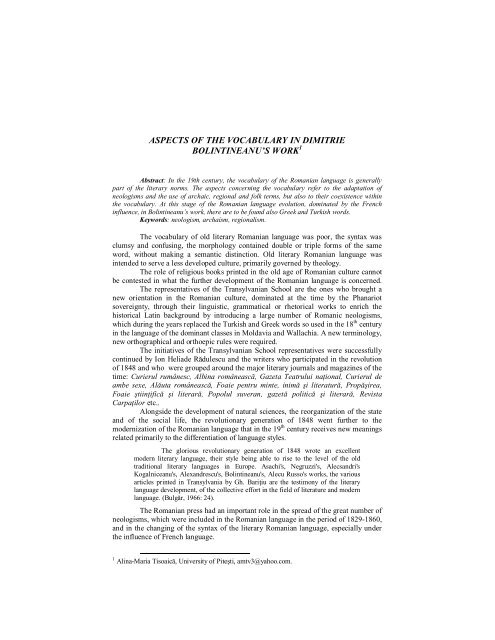language and literature european landmarks of identity
language and literature european landmarks of identity
language and literature european landmarks of identity
Create successful ePaper yourself
Turn your PDF publications into a flip-book with our unique Google optimized e-Paper software.
ASPECTS OF THE VOCABULARY IN DIMITRIE<br />
BOLINTINEANU’S WORK 1<br />
Abstract: In the 19th century, the vocabulary <strong>of</strong> the Romanian <strong>language</strong> is generally<br />
part <strong>of</strong> the literary norms. The aspects concerning the vocabulary refer to the adaptation <strong>of</strong><br />
neologisms <strong>and</strong> the use <strong>of</strong> archaic, regional <strong>and</strong> folk terms, but also to their coexistence within<br />
the vocabulary. At this stage <strong>of</strong> the Romanian <strong>language</strong> evolution, dominated by the French<br />
influence, in Bolintineanu’s work, there are to be found also Greek <strong>and</strong> Turkish words.<br />
Keywords: neologism, archaism, regionalism.<br />
The vocabulary <strong>of</strong> old literary Romanian <strong>language</strong> was poor, the syntax was<br />
clumsy <strong>and</strong> confusing, the morphology contained double or triple forms <strong>of</strong> the same<br />
word, without making a semantic distinction. Old literary Romanian <strong>language</strong> was<br />
intended to serve a less developed culture, primarily governed by theology.<br />
The role <strong>of</strong> religious books printed in the old age <strong>of</strong> Romanian culture cannot<br />
be contested in what the further development <strong>of</strong> the Romanian <strong>language</strong> is concerned.<br />
The representatives <strong>of</strong> the Transylvanian School are the ones who brought a<br />
new orientation in the Romanian culture, dominated at the time by the Phanariot<br />
sovereignty, through their linguistic, grammatical or rhetorical works to enrich the<br />
historical Latin background by introducing a large number <strong>of</strong> Romanic neologisms,<br />
which during the years replaced the Turkish <strong>and</strong> Greek words so used in the 18 th century<br />
in the <strong>language</strong> <strong>of</strong> the dominant classes in Moldavia <strong>and</strong> Wallachia. A new terminology,<br />
new orthographical <strong>and</strong> orthoepic rules were required.<br />
The initiatives <strong>of</strong> the Transylvanian School representatives were successfully<br />
continued by Ion Heliade Rădulescu <strong>and</strong> the writers who participated in the revolution<br />
<strong>of</strong> 1848 <strong>and</strong> who were grouped around the major literary journals <strong>and</strong> magazines <strong>of</strong> the<br />
time: Curierul rumânesc, Albina românească, Gazeta Teatrului naţional, Curierul de<br />
ambe sexe, Alăuta românească, Foaie pentru minte, inimă şi literatură, Propăşirea,<br />
Foaie ştiinţifică şi literară, Popolul suveran, gazetă politică şi literară, Revista<br />
Carpaţilor etc..<br />
Alongside the development <strong>of</strong> natural sciences, the reorganization <strong>of</strong> the state<br />
<strong>and</strong> <strong>of</strong> the social life, the revolutionary generation <strong>of</strong> 1848 went further to the<br />
modernization <strong>of</strong> the Romanian <strong>language</strong> that in the 19 th century receives new meanings<br />
related primarily to the differentiation <strong>of</strong> <strong>language</strong> styles.<br />
The glorious revolutionary generation <strong>of</strong> 1848 wrote an excellent<br />
modern literary <strong>language</strong>, their style being able to rise to the level <strong>of</strong> the old<br />
traditional literary <strong>language</strong>s in Europe. Asachi's, Negruzzi's, Alecs<strong>and</strong>ri's<br />
Kogalniceanu's, Alex<strong>and</strong>rescu's, Bolintineanu's, Alecu Russo's works, the various<br />
articles printed in Transylvania by Gh. Bariţiu are the testimony <strong>of</strong> the literary<br />
<strong>language</strong> development, <strong>of</strong> the collective effort in the field <strong>of</strong> <strong>literature</strong> <strong>and</strong> modern<br />
<strong>language</strong>. (Bulgăr, 1966: 24).<br />
The Romanian press had an important role in the spread <strong>of</strong> the great number <strong>of</strong><br />
neologisms, which were included in the Romanian <strong>language</strong> in the period <strong>of</strong> 1829-1860,<br />
<strong>and</strong> in the changing <strong>of</strong> the syntax <strong>of</strong> the literary Romanian <strong>language</strong>, especially under<br />
the influence <strong>of</strong> French <strong>language</strong>.<br />
1 Alina-Maria Tisoaică, University <strong>of</strong> Piteşti, amtv3@yahoo.com.


